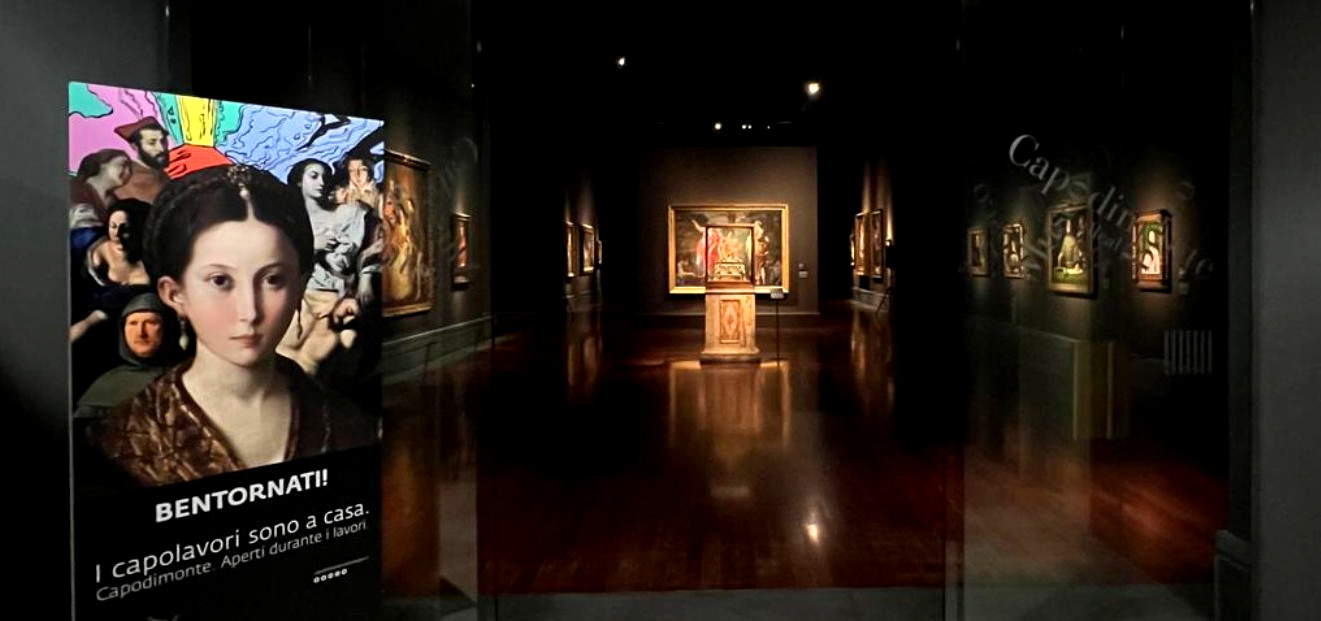Eighteen of Capodimonte's iconic masterpieces returned after lengthy loans: now all are reunited in one room
Eighteen iconic works from the Museo e Real Bosco di Capodimonte’scollections, all just returned from long loans in Italy and abroad, will be brought together starting Oct. 24 in a new display in Room 62 on the museum’s second floor: These include Titian’s Danae and the Portraits of Paul III, Parmigianino’s Antea, Artemisia Gentileschi’s Judith Beheading Holofernes, and Caravaggio’s The Flagellation (Property of the Interior Ministry’s Worship Buildings Fund) absent from the Neapolitan museum premises for more than two and a half years.
The new display is intended not only to celebrate the return to Naples of some of the museum’s most representative works, but also to retrace as in an ideal anthology the history of Capodimonte’s collecting: the Farnese, the Bourbons, Italian purchases, donations up to contemporary art.
Room 62 has been divided into two parts by a plasterboard wall. On the right is The Portrait of Luca Pacioli (attributed to Jacopo de’ Barbari, 1495), an iconic image of the mathematician and author of the Summa de Arithmetica. Next to that of the founder of Accountancy, other famous portraits from the Veneto area are offered: they are Bernardo de’ Rossi, Bishop of Treviso (1505) by Lorenzo Lotto and two works by El Greco, the Portrait of Giulio Clovio (1571-1572) and El soplón (1570-1572).
In the center of this first space is the Cassetta Farnese, a masterpiece of 16th-century goldsmithing. It continues with Hercules at the Crossroads by Annibale Carracci (1596), and on the left, with three works by Titian: Portrait of Pope Paul III bareheaded (1543), Portrait of Pope Paul III with his nephews Alessandro and Ottavio Farnese (1545-1546), and Portrait of Cardinal Alessandro Farnese (1545-1546).
In the second part of the room, Titian’s Danae (1544-1545), Parmigianino’s Antea (1535) and Lucrezia (1540), the St.Agatha by Francesco Guarino (1637-1640, Bourbon Collection), Bernardo Cavallino’s Saint Cecilia in Ecstasy (1645), of which both the sketch from the Bourbon Collection and the canvas, assigned to Capodimonte in 1984 after postwar recovery, Judith Beheading Holofernes by Artemisia Gentileschi (1612-1613, Bourbon Collection) are on display.
Caravaggio’sFlagellation (1607), a work kept in the Capodimonte Museum since 1972, was instead placed at the end of the room. Andy Warhol’s Vesuvius (1985), donated by Lucio Amelio, closes the itinerary, opposite the Merisi.
“The identity of the historical collections of Capodimonte is a heritage of Naples. With the return home of so many iconic works and their rearrangement, a new phase begins today, also in the museum’s dialogue with its territory,” said Director of the Capodimonte Museum and Real Bosco Eike Schmidt. “This does not mean that our masterpieces should be considered all and always immovable. However, we want the museum to re-establish itself as a must-see destination for Italian cultural tourism, with flows more in line with its prestige, that citizens attend it with pride, recognizing themselves in its history in order to pass it on to the younger generations. Capodimonte must once again become known, valued and communicated for the immense wealth of its picture gallery, second in Italy only to the Uffizi, and surrounded by the magnificent Real Bosco, the largest urban park in Europe. The choice of this display that brings together eighteen major works, long absent from the museum, was also dictated by the ongoing work on the digital and ecological transition. The result, however, is magnificent. Certainly such a dense and exciting visit can only happen here, at Capodimonte.”
Visitors will also be able to see a preview of the Grande Capodimonte project in the refurbished hall: in fact, the lighting interventions (replacement of lamps with energy-saving LED technology) planned in the entire palace by the innovative Lighting concept have already been carried out. Since last December, the museum has started its energy, digital and economic transition in partnership with Engie. With “phased construction,” only certain areas and sections of the museum will remain closed until December 2025, and the public will be assured of access to the main collections that now return to full use.
 |
| Eighteen of Capodimonte's iconic masterpieces returned after lengthy loans: now all are reunited in one room |
Warning: the translation into English of the original Italian article was created using automatic tools. We undertake to review all articles, but we do not guarantee the total absence of inaccuracies in the translation due to the program. You can find the original by clicking on the ITA button. If you find any mistake,please contact us.



























